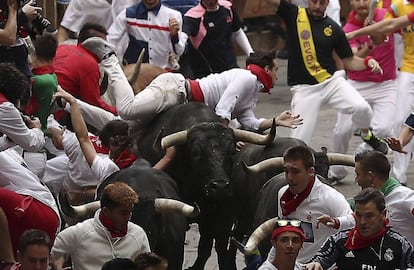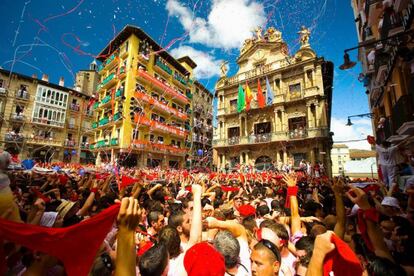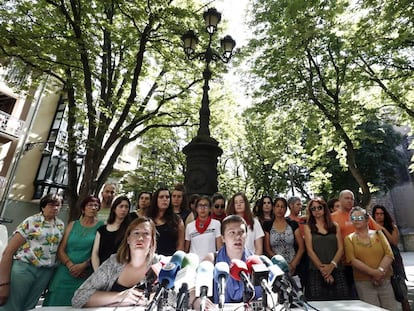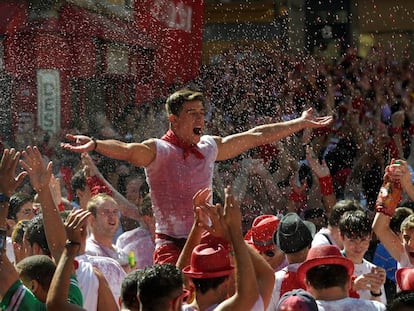Pamplona smells of bulls
From the morning runs to the evening bullfights to the all-night partying, there is fiesta in the air

Pamplona has been smelling of bulls for days. The indisputable stars of the festival of San Fermín were the first to arrive here. They are now resting inside the Del Gas bullpens while thousands of tourists from across the globe make their way to this northern Spanish city to take part in one of the most international, raucous, diverse and emblematic fiestas in the entire world; a veritable Tower of Babel at whose apex stands the proud bull, the animal that brings meaning to Pamplona and to the Sanfermines.
The end of the road is not the pasture, it is the bullring
From the morning runs through the streets of the city to the evening bullfights, the animal’s image is present everywhere. While Pamplona puts the finishing touches to the fiestas, the bulls wait patiently for el chupinazo, the rocket that will be fired from City Hall at noon on Friday to signal the opening of the 2018 Sanfermines. At that point, the countdown will begin for the first encierro, that headlong, dangerous and exciting morning race that is always rife with tension, fear, jostling, pile-ups and, just perhaps, the first scratch or drop of blood on a runner who has been too bold, or too absent-minded, or just plain unlucky.
Then will come everything else: the food, the parades of Gigantes y Cabezudos – giants and oversized heads made of papier mâché – the music, the dancing, the chistorra sausage, the artichokes, the Piquillo peppers, the calimocho (a drink made of cheap red wine and cola soda), the pacharán (a liqueur typical of northern Spain made with blackthorn fruits), the procession to the bullring, the fight, the overpowering noise, the party-hardy crowds, and the all-night celebrations until dawn breaks, announcing the start of a whole new encierro.
Everything is ready for the fiesta: the barricades, the meats, the drinks, the white outfits, the red bandanas and the 490 official events that the city has programmed for revelers of all ages on a €1.36 million budget.
The bulls are ready, too. The first ones hail from the Puerto de San Lorenzo ranch in Salamanca, and they arrived in Pamplona on June 28. They have since been joined by animals marked with the José Escolar, Cebada Gago, Fuente Ymbro and Núñez del Cuvillo brands.

The route that the bulls and runners will take is also ready. On Monday night, workers applied a non-skid liquid on some stretches, to help the bulls’ hooves get a better grip and prevent them from skidding out of control, especially on rainy days.
The fiesta officially begins on Friday at noon, when a rocket will be fired from the balcony of City Hall. The first run will take place on Saturday morning. At 8am, another rocket will signal the opening of the pen gates at Corral de Santo Domingo, where the animals will have spent the night after being transferred there from the Corrales del Gas.
At this point, the runners will attempt to shake off their nerves by pressing themselves against the walls of streets that have become household names: Cuesta de Santo Domingo, Plaza del Ayuntamiento, the curve on Mercaderes, Estafeta street, the Telefónica stretch, and the underpass leading into the bullring. It is 875 meters through the historical part of town, as the bulls do their best to flee the masses and find their way back to their pasture.

But the end of the road is not the pasture – it is the bullring pen. This is where they will spend their last few hours before the corrida begins at 6.30pm. At this point, another one of the central rites of San Fermín will take place: this is where, amid the incessant chanting by the fans in the sun-drenched seating area, and the respectful silence of those in the shady seats, the boldest toreros will risk their lives by pitting their wits against the top bulls of the season, those with the longest and sharpest horns.
And when it’s all over, the Casa de Misericordia (MECA), the private charity that owns the bullring and organizes the fights, will be using the proceeds to cover 30% of the cost of running a senior residence that is home to 530 people. It is MECA that decides which ranches and which toreros will participate in the San Fermín festival each year. Free from the constraints of the bullfighting industry, they strive to bring the animals and fighters most likely to perform well in the ring, although they don’t always manage it.
But the ring – all 19,721 seats of it – will be nearly filled to capacity every evening during Sanfermines. This year, there are eight corridas, one rejoneo (bullfighting on horseback) and one novillada (a fight between a younger animal and a less experienced torero) on the program. Top billing goes to the bullfighters Octavio Chacón, Emilio de Justo, Juan José Padilla, Pepín Liria, Roca Rey and Ginés Marín.
English version by Susana Urra.
Tu suscripción se está usando en otro dispositivo
¿Quieres añadir otro usuario a tu suscripción?
Si continúas leyendo en este dispositivo, no se podrá leer en el otro.
FlechaTu suscripción se está usando en otro dispositivo y solo puedes acceder a EL PAÍS desde un dispositivo a la vez.
Si quieres compartir tu cuenta, cambia tu suscripción a la modalidad Premium, así podrás añadir otro usuario. Cada uno accederá con su propia cuenta de email, lo que os permitirá personalizar vuestra experiencia en EL PAÍS.
¿Tienes una suscripción de empresa? Accede aquí para contratar más cuentas.
En el caso de no saber quién está usando tu cuenta, te recomendamos cambiar tu contraseña aquí.
Si decides continuar compartiendo tu cuenta, este mensaje se mostrará en tu dispositivo y en el de la otra persona que está usando tu cuenta de forma indefinida, afectando a tu experiencia de lectura. Puedes consultar aquí los términos y condiciones de la suscripción digital.
More information
Archived In
Últimas noticias
Most viewed
- Pablo Escobar’s hippos: A serious environmental problem, 40 years on
- Reinhard Genzel, Nobel laureate in physics: ‘One-minute videos will never give you the truth’
- Why we lost the habit of sleeping in two segments and how that changed our sense of time
- Charles Dubouloz, mountaineering star, retires at 36 with a farewell tour inspired by Walter Bonatti
- The Florida Keys tourist paradise is besieged by immigration agents: ‘We’ve never seen anything like this’











































